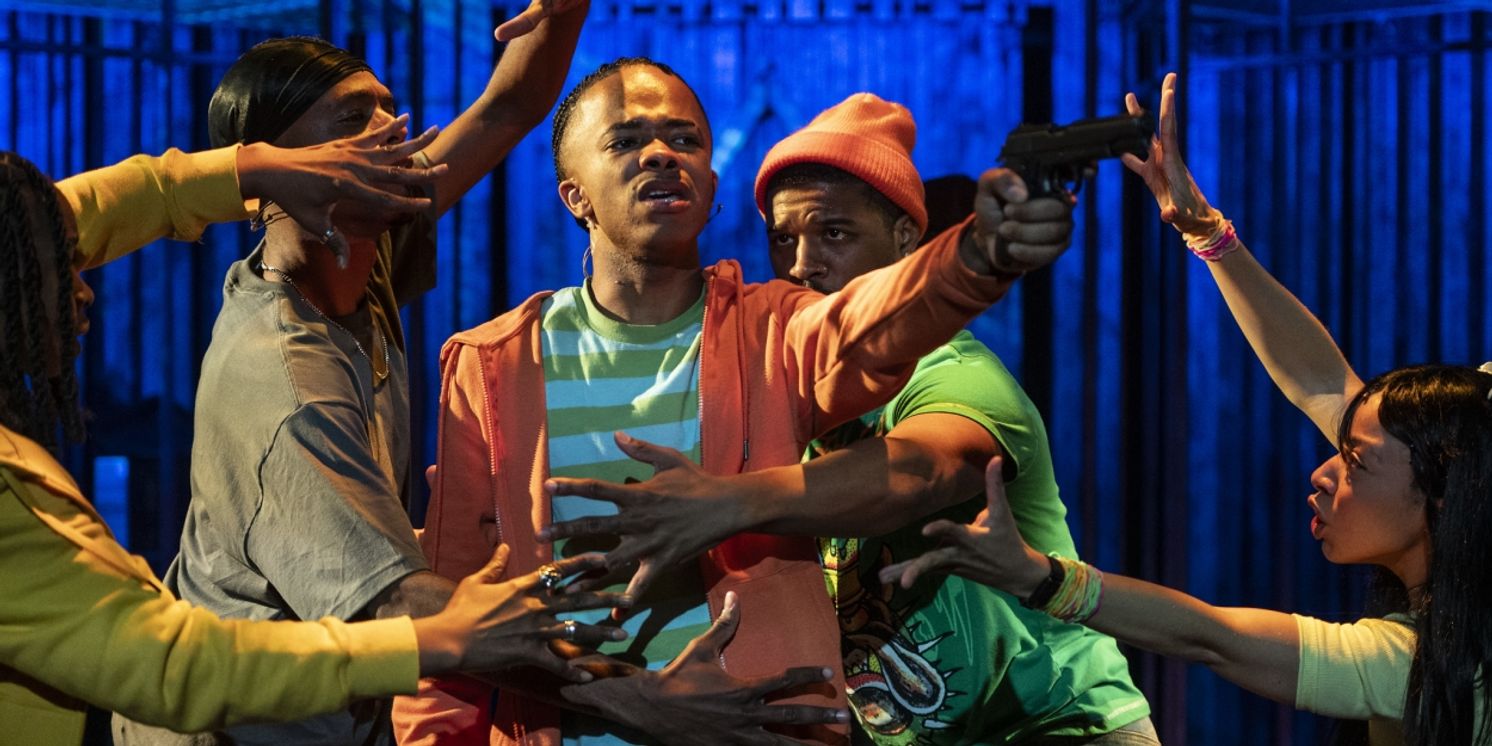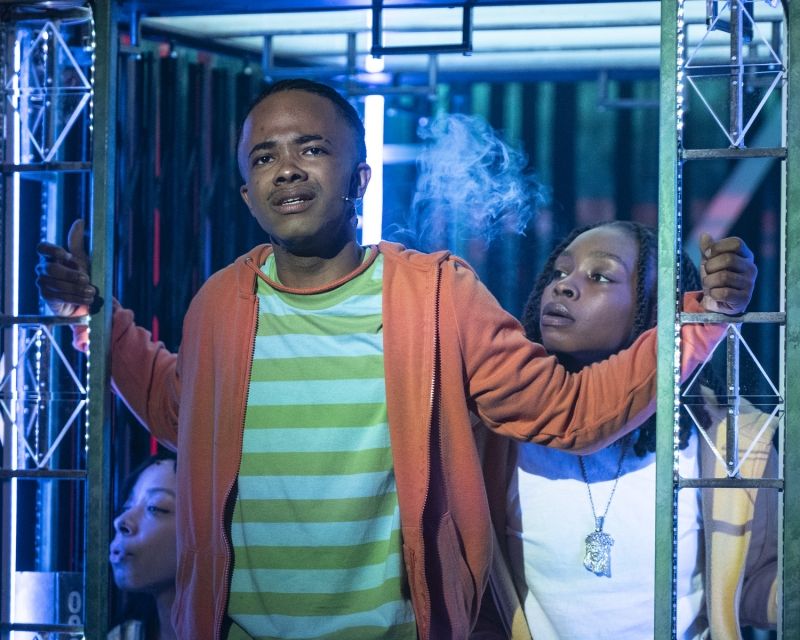Review: LONG WAY DOWN at Olney Theatre Center
The production runs through June 23rd

On May 25th, Olney Theatre Center unveiled the world premiere of the musical Long Way Down at the Mulitz-Gudelsky Theatre Lab. The piece was adapted from Jason Reynolds's novel of the same name, which has received accolades such as the National Book Award and a Newbery Medal, and was written (books, music, and lyrics) by Dahlak Brathwaite, with additional writing (books, music, and lyrics) by Khiyon Hursey.
It follows a young boy named Will (Tyrese Shawn Avery), who lives with his mother, Shari (Io Browne), and his older brother, Shawn (Victor Musoni). Will's father, Mike (Quincy Vicks), died when Will was young, and since then, he has become obsessed with anagrams, words, and letters. Shawn however, being a little older has picked up some more dangerous habits. While it is never explicitly referenced, he is assumedly engaged in some sort of organized criminal activity, perhaps a gang with a rival organization.
A dynamic is immediately established wherein Will admires Shawn, wants his approval, and to be like him, whereas Shawn worries about the naivety and safety of his younger brother. Reluctantly Shawn teaches Will the three rules of his lifestyle, don't cry, don't snitch, and get revenge.
Unfortunately, the culture of casual violence and organized crime is rampant in Will's world, and there are constant casualties, above all of them being Shawn, who gets shot near the beginning of the show. The meat of the show begins when Will decides to follow the rules and get revenge against the boy who killed his brother, by using Shawn's gun to return the favor.
He prepares himself and takes the elevator down to the ground floor. In the elevator, he meets ghosts of neighbors and loved ones who passed due to or around similar types of violence. Thus begins the almost Dickensian tale, where the ghosts try to sway Will in either direction, and he desperately grapples with his conscious, their influence, and his feelings about his family.
These parables come by way of frequent musical numbers, varying in genre and length. The music which was played live band (Cedric Lyles on keys and conducting, J Anthony Dix on Bass, and Evander McLean on percussion), was original (save for a very faint background playing of "Back That Azz Up" by Juvenile), and performed for an audience the first time at the premiere. It was enjoyable, at times vivacious and referencing older Hip-Hop and Tap, and other times smooth, with more of an R&B feel (one number in particular felt like a Frank Ocean b-side). Though, as mentioned, it spanned different genres and moods, it was altogether cohesive and engaging. The more Hip-Hop songs did feel, for better or worse, like Hip-Hop written for Musical Theatre, the lyricism was tight and clever.
The musical performances however outshined the songwriting. It is no wonder Avery was cast in this role, his vocals were savored by the audience for good reason, and the quality of his singing was consistent throughout the show. There really wasn't a weak link in terms of performances, vocal or otherwise, though Parris Lewis's Buck stole plenty of scenes throughout the show and gave a particularly enjoyable performance.
Intertwined with the music was the choreography by the director, Ken-Matt Martin, as well as Musoni. The dancing was most effectively used to punctuate emotion. The contemporary, almost snappy style of dance, particularly during Musoni's solos worked with the music to transcend any need for verbal language in the moment. While there was plenty of great dancing, it would be hard to call it a "dance-heavy" show, which feels appropriate. More dancing, or even more typical ensemble musical theater dancing wouldn't have felt right, and perhaps would've felt out of place, too large for the more intimate nature of the piece.

Photo credit: Teresa Castracane Photography
The show, even though it had plenty of moments of lightness and laughter, deals with intense and heavy subject matter. It's concerned with exploring (and perhaps educating audiences) the cyclical nature of the violence that so affects Will, what it might take to break the cycle, and the toll it takes on those who perpetuate it, and in particular, those around them.
From its source material, to its writers, its performers, and the communities it portrays, it's focused on bringing into light a situation many young Black people find themselves in. The question is raised, will Will break this cycle, or keep the wheels turning? And is he at fault if he chooses one over the other? The immense responsibility represented by the ghosts "haunting him," plague Will. At times he is steadfast: he must honor his brother, his father, his uncle, and himself and carry out this act. At others he is defeated: is he ready to corrupt his soul? To endanger himself and the little family he has left? To end his childhood? The show explores how different people are victims of this cycle in varying ways. And while it doesn't dive too deep into it, it references the police state and intersectional systems of oppression.
The set consisted of two floors: the stage floor, and the constructed second floor. The second floor was a balcony of sorts, accessed by the actors via an onstage ladder and off-stage stairs (presumably). Simean Carpenter, who is also responsible for the lighting, crafted a muteable, transient space. The decorative decisions were a bit unexpected. The walls of the suggested apartment building were slatted and appeared to be textured variations of viridian and black. This turquoise-y pigment carried itself throughout the set, appearing on chairs and benches. Though this did not have any bearing on the perception of the show, it is hard for those slats not to evoke the work/world of Delia Deetz from Beetlejuice.
The metal holding up the balcony was a contrast red, thin, and in a quasi-art-deco formation, which provided an interesting visual conversation. Throughout the stage, there were also five sets of two equilateral triangles, of course representing the two choices Will is faced with, on or no, up or down. These triangles lit up in different colors and were used to effectuate music, theme, and dialogue. If one wanted to be semiotic about it, those triangles could also allude to the alchemical symbols for fire and water, just another way to drive home the messages of the show.
The symbol adorned the elevator set piece many times over. Being that the "real world" of the show takes place mostly within the elevator, it makes sense that it was the most dynamic piece. It moved, it lit up, it even smoked. It also provided probably Martin's most interesting blocking. There were times when up to five actors were all occupying that small space in the elevator, squirming, flowing, and navigating all around each other, perhaps echoing the infinite lives, stories, and perspectives that exist, and are stopped too short in the apartment building, neighborhood, world, etc.
A special blink-and-you-might-miss-it moment comes by way of blacklights. During a number where Will debates his paths, they light up the words "on" and "no" scribbled over and over all across the stage. It's a smaller aspect of the set, but one that is indicative of the deep consideration from the designer, particularly when it comes to supporting and uplifting the text.
The costumes, designed by Danielle Preston, also did a great deal to communicate to the audience the world within which the characters live. Almost all the costumes were believable and felt lived in, they were effective in that they felt not really like costumes at all. Unfortunately, however, some did feel quite costumey. Dani sported a boho, 70s-inspired ensemble, complete with fringe boots and hippie hair. It's not that the character can't rock boho style, it's that it almost felt like Dani had died on Halloween dressed as a hippie, and must stay in it for as long as she's in purgatory. Luckily though, Dyllan's performance was genuine, earnest, and very enjoyable. A smaller qualm came with Will's ensemble. It's apparent that there was an effort to age down Avery, understandably, to a younger teenager, however his hoodie, and in particular his striped tee shirt felt almost too non-descript.
Particular attention to detail with costumes was apparent when it came to time period. While the show never explicitly states when (or where) it takes place, it is able to situate itself pretty clearly when it comes to who was alive when, as well as flashbacks. Though their outfits are coming back in style, both Mark (Naiqui Macabroad) and Mike, who died further back in the past than the other ghosts, felt more evocative of the 90s, whereas Buck and Frick (Colin Carswell) sport contemporary styles. Shawn's graphic tees also do a good job of situating us in the present.

Photo: Teresa Castracane Photography
After taking the journey with Will, meeting the ghosts, and pondering the circumstances, the audience is left with a lot to chew on. How does the show permeate the world we live in? Is it illustrative of people in our own communities? Are we privileged enough to be alien to this type of violence? The shower doesn't necessarily have the answers, but its work is in asking the question.
An exciting piece of theatre, Long Way Down runs through June 23rd. Information on tickets, including audio-described performances, sign-interpreted performances, and BLACK Out Night can be found on Olney Theatre's website.
Reader Reviews
Videos

